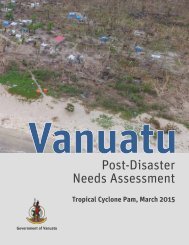Fiji
yqgk302EGjo
yqgk302EGjo
You also want an ePaper? Increase the reach of your titles
YUMPU automatically turns print PDFs into web optimized ePapers that Google loves.
FIJI Post-Disaster Needs Assessment<br />
Losses to the Health Sector (F$6 million)<br />
Total losses for the health sector were estimated to be approximately F$6.2 million (see Table 42). Losses incurred post-TC<br />
Winston include psychosocial support and psychological first aid provided by development partners, NGOs and MoHMS<br />
to affected population. Retired nurses were reengaged to assist medical teams that provided immediate medical care to<br />
affected communities in the aftermath of TC Winston. Losses include: costs associated with additional outreach activities<br />
conducted following Winston; and increased operational costs associated with such activities that were calculated as<br />
increased expenditure by the health sector during the disaster emergency period. 80<br />
Approximately F$3.6 million was used by MoHMS to purchase additional drugs and supplies and F$0.3 million for additional<br />
service delivery costs. Approximately F$0.7 million was used by the Ministry from its own budget for operational expenses<br />
related to TC Winston.<br />
Table 42: Damage and Losses to the Health Sector by Division (F$ million)<br />
Damage Losses Total Effects<br />
Central 2.6 0.8 3.4<br />
Western 2.1 1.2 3.3<br />
Northern 0.4 0.3 0.7<br />
Eastern 2.6 0.5 3.1<br />
Headquarters – MoHMS 0.0 0.1 0.1<br />
National level 0.0 3.4 3.4<br />
Total 7.7 6.3 14.0<br />
Source: Estimations by Assessment Team.<br />
Social Impact of Damage and Losses<br />
The disaster has affected economic and physical access to food. The extensive destruction of agricultural produce could<br />
have serious repercussions for food security and nutrition in both the short and long term. Because some of the nutritional<br />
impacts may not become evident until the harvest season begins, the government and development partners may be<br />
prompted to end food rations prematurely. The assessment of fisheries indicates that fisheries resources may take more<br />
than 10 years to recover. This could have serious consequences for nutrition, which is already suffering from the population’s<br />
increased preference for cheaper but less nutritious foods, such as instant or tinned foods.<br />
Malnutrition usually comes a few months after a disaster has occurred and sometimes even a year later. As families struggle<br />
to meet competing basic needs on reduced incomes, some of their coping mechanisms may include reducing the amount<br />
and nutritional quality of the food they eat. A focus on restoring homes and livelihoods without a focus on maintaining<br />
proper nutritional levels could, therefore, come at the cost of the health of children and pregnant or lactating women. While<br />
some households are actually reporting temporary increases in food intake because of food rations being distributed by<br />
the government, NGOs and donor partners, households in remote areas (such as Yasawasa and Burewaki villages in the<br />
Western and Eastern Divisions, respectively) are already facing food challenges. In Burewaki, women reported that they<br />
are only eating twice a day because they lack sufficient food. Furthermore, MoHMS is already recording an increase in<br />
malnutrition among children, including on Koro Island. 81 Sustained surveillance of nutrition status among children, pregnant<br />
women and lactating mothers is essential. Food supplements (through programmes, such as the Expanded Food Voucher<br />
Programme for pregnant women in rural areas) should be provided to pregnant and lactating women in the most affected<br />
districts to reduce malnutrition and anaemia, while targeted nutrition programmes for children in areas already reporting<br />
malnutrition cases should be increased and scaled up.<br />
Teenage pregnancy is a growing sexual and reproductive health issue in <strong>Fiji</strong>. 82 Evidence from the 2012 floods suggests that<br />
women and girls who lacked access to food were offering sex in exchange for food as a coping mechanism. Anecdotal<br />
reports suggest that exchanges of this type are already happening in some parts of <strong>Fiji</strong>. 83 Reproductive health services and<br />
outreach by the government and NGOs should, therefore, be strengthened to provide critical services, including maternal<br />
health/family planning, assistance in responding to sexual violence, and adolescent sexual reproductive health services<br />
and information.<br />
80<br />
The reported figures only represent services delivered through the public sector. No data are available for the impact of TC Winston on<br />
health services through the private sector, as no requirements exist for private services to report to MoHMS.<br />
81<br />
Screening has identified 80 cases of moderate acute malnutrition: 33 in Koro, 17 in Taveuni and the rest in other affected areas. It has also<br />
identified 28 cases of severe acute malnutrition: 7 in Koro and 9 from Taveuni. Thus, most of the cases detected so far were from Koro<br />
and Taveuni.<br />
82<br />
ADB, “<strong>Fiji</strong> Country Gender Assessment,” 2015.<br />
83<br />
The inference is based on the Gender Based Violence Subcluster Advocacy Note, “Gender-Based Violence in the Aftermath of the <strong>Fiji</strong><br />
Tropical Cyclone Winston.”<br />
70 Tropical Cyclone Winston, February 20, 2016



